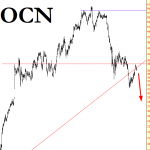In what is the first official warning to a central bank to no longer do what has been done so far for seven years, earlier today Deutsche Bank came out with a startling presentation addressed to Mario Draghi, warning him explicitly that any more QE will not only not help stocks (and certainly not DB stock which continues to plumb post-crisis lows on fears it is overexposed to the commodity crunch and potentially such names as Glencore and various other commodity traders), but will actually push equities lower.
Here is the key segment from a report just released by the bank’s European Equity Strategy:
While the outlook for more ECB easing has buoyed equity markets, we think it could turn out to be a negative for risk over the coming months, as it is likely to lead to further dollar strength, which in turn is set to translate into additional downside pressure on the oil price, further balance sheet stress in the US energy space and higher US high-yield credit spreads . Our models suggest that European equities are fairly valued, given the current level of US high-yield spreads. If more dollar strength and weaker oil lead US speculative default rates to rise above the level of around 4% currently priced into the credit market, this could mean more upside risk for HY credit spreads and more downside risk for equities over the coming months.
A lose-lose currency war policy dilemma, you say? Why yes, yes it is:
We see four pathways from ECB easing to further stronger strength: (a) against the backdrop of a Fed that remains committed to its tightening agenda, further ECB easing is likely to lead to more downside of the euro against the dollar; (b) more ECB easing puts pressure on the Bank of Japan to intensify its own easing program; (c) ECB-inspired euro weakness puts upward pressure on the new CNY basket, increasing the likelihood of a renewed Chinese FX devaluation; (d) the more expected ECB easing calms the market in the near-term, the more likely the Fed is to hike again over the coming months, adding to yield support for the dollar.













Leave A Comment